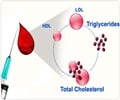A key regulator of cholesterol and fat metabolism in the liver also plays an important role in the development of liver fibrosis, scientists have found.

The study has shown that liver X receptors (LXRs), master regulators of cholesterol, fat and inflammatory gene expression, also control the fibrosis-making cells of the liver, known as hepatic stellate cells.
In the face of chronic liver injury - due to excess fat, chronic viral hepatitis or alcohol abuse, for example - stellate cells become activated and launch an inflammatory and fibrotic cascade that eventually results in the build-up of collagen scar tissue in the liver.
LXRs, when stimulated, "turn on" several hundred genes that hold instructions to create proteins for carrying out bodily processes in cells, from transporting and excreting cholesterol to synthesizing fat in the liver. They have also been shown to suppress inflammatory processes in several contexts.
UCLA researchers have found that LXRs normally play a role in helping to reduce the collagen-producing actions of stellate cells when the cells are "activated" by liver damage.
For the study, UCLA scientists first tested how activated stellate cells taken from mice would react when a chemical that induces LXR activity was added to the cell culture.
Advertisement
"We showed that LXRs dampen stellate cell activation by repressing inflammatory and collagen-producing genes," said lead author Simon Beaven, an assistant professor of digestive diseases at the David Geffen School of Medicine at UCLA.
Advertisement
These cells then showed a markedly exaggerated inflammatory and collagen-producing response, suggesting that LXR-deficient stellate cells are secreting signals to promote fibrosis.
The researchers noted that these experiments demonstrate that LXRs control a fibrotic response in stellate cells that can have a wide influence on neighboring cells.
The scientists also found that after replicating chronic liver injury, mice without LXRs had dramatically more liver fibrosis than normal mice.
"The genetic loss of LXRs rendered the mice susceptible to developing fibrotic liver disease," Beaven said.
The study was published in the March issue of the journal Gastroenterology.
Source-ANI














